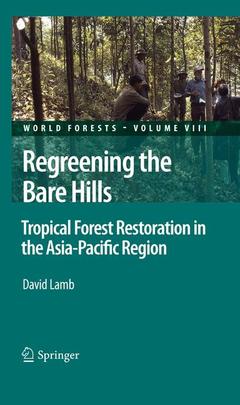Description
Regreening the Bare Hills, 2011
Tropical Forest Restoration in the Asia-Pacific Region
World Forests Series, Vol. 8
Author: Lamb David
Language: English
Subjects for Regreening the Bare Hills:
Keywords
Degraded; Landscape; Rehabilitation; Restoration; Tropical forest
Approximative price 210.99 €
In Print (Delivery period: 15 days).
Add to cartPublication date: 12-2012
550 p. · 15.5x23.5 cm · Paperback
Approximative price 210.99 €
In Print (Delivery period: 15 days).
Add to cartPublication date: 10-2010
550 p. · 15.5x23.5 cm · Hardback
Description
/li>Contents
/li>Comment
/li>
In Regreening the Bare Hills: Tropical Forest Restoration in the Asia-Pacific Region, David Lamb explores how reforestation might be carried out both to conserve biological diversity and to improve the livelihoods of the rural poor. While both issues have attracted considerable attention in recent years, this book takes a significant step, by integrating ecological and silvicultural knowledge within the context of the social and economic issues that can determine the success or failure of tropical forest landscape restoration.
Describing new approaches to the reforestation of degraded lands in the Asia-Pacific tropics, the book reviews current approaches to reforestation throughout the region, paying particular attention to those which incorporate native species ? including in multi-species plantations. It presents case studies from across the Asia-Pacific region and discusses how the silvicultural methods needed to manage these ?new? plantations will differ from conventional methods. It also explores how reforestation might be made more attractive to smallholders and how trade-offs between production and conservation are most easily made at a landscape scale. The book concludes with a discussion of how future forest restoration may be affected by some current ecological and socio-economic trends now underway.
The book represents a valuable resource for reforestation managers and policy makers wishing to promote these new silvicultural approaches, as well as for conservationists, development experts and researchers with an interest in forest restoration. Combining a theoretical-research perspective with practical aspects of restoration, the book will be equally valuable to practitioners and academics, while the lessons drawn from these discussions will have relevance elsewhere throughout the tropics.
Describes new approaches to help overcome forest degradation in the Asia-Pacific region Provides an up-to-date review of different reforestation strategies used in different places, explores the scope for using these in other ecological, socio-economic situations Reviews reforestation from a site and landscape perspective Addresses trade-offs in balancing the need for economic gains from reforestation with the need to restore forest cover to conserve biodiversity
Includes supplementary material: sn.pub/extras
These books may interest you

Large-scale Forest Restoration 56.31 €

Large-scale Forest Restoration 172.36 €


